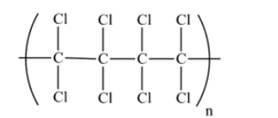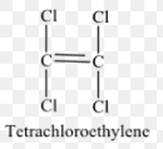
(a)
Interpretation:
A portion of the polymer made from tetrachloroethylene needs to be drawn.
Concept Introduction:
A polymer is a long chain consists of large number of monomer units. In a polymer, the monomers are linked to each other in a continuous or repetitive manner. These monomer units are linked to each other either through the formation of peptide linkage,glycosidic linkage or by removal of any moiety such as a water molecule.Polyvinyl chloride, Bakelite and polystyrene are some of the examples of the
(a)
Answer to Problem 1QAP
A portion of polymer made from tetrachloroethylene is as follows:

Explanation of Solution
Tetrachloroethylene polymer consists of number of monomer unit of 1,1,2,2-tetrachloroethylene.
The structure of tetrachloroethylene or monomer unit of the polymer is as follows:

The polymer is formed after breaking of C-C double bonds, the two terminal carbon atoms of 1 tetrachloroethylene unit form bond with 2 terminal carbons of two other tetrachloroethyleneunits. To form a polymer, n numbers of such tetrachloroethyleneunits combined in the same way.
A portion of this polymer is shown as follows:

(b)
Interpretation:
The molar mass of the polymer needs to be calculated if it contains
Concept Introduction:
A polymer is a long chain consists of large number of monomer units. In a polymer, the monomers are linked to each other in a continuous or repetitive manner. These monomer units are linked to each other either through the formation of peptide linkage, glycosidic linkage or by removal of any moiety such as a water molecule. Polyvinyl chloride, Bakelite and polystyrene are some of the examples of the polymers.
Tetrachloroethylene polymer consists of number of monomer unit of 1,1,2,2-tetrachloroethylene.
(b)
Answer to Problem 1QAP
The molar mass of complete polymer is
Explanation of Solution
Molar mass of 1 monomer unit of 1,1,2,2-tetrachloroethylene is 168 g /mol. This is mass of 1 molecule of the 1,1,2,2-tetrachloroethylene.
If the polymer contains
Thus, molar mass of complete polymer is
(c)
Interpretation:
The mass percent of C and Cl in the polymer needs to be determined.
Concept Introduction:
Mass percent of an atom present in the sample can be determined by dividing mass of atom present in the monomer to the overall mass of the monomer unit and multiplying the overall result with 100%.
For example, the mass percent of x g of an atom present in the y g of monomer unit can be determined as:
(c)
Answer to Problem 1QAP
Mass percent of C in polymer is 14.28 %.
Mass percent of Cl in polymer is 83.33 %.
Explanation of Solution
The molar mass of the 1 tetrachloroethylene unit is 168 g/mol.
There are 2 C atoms in a monomer unit of tetrachloroethylene.
Now, molar mass of C atom in a monomer will be:
Putting the values,
Thus, mass percent of C in polymer is 14.28 %.
The number of Cl atoms in the monomer unit of tetrachloroethylene is 4.
Molar mass of Cl in a monomer will be:
Mass percent of Cl can be calculated as follows:
Putting the values,
Thus, mass percent of Cl in the polymer is 83.33 %
Want to see more full solutions like this?
Chapter 23 Solutions
Chemistry: Principles and Reactions
- 4) A compound called vinyl chloride has a composition of 38.43% carbon, 4.838% hydrogen, and 56.72% chlorine. When vinyl chloride is polymerized (many single units linked together to form a long chain) under certain conditions, a white solid called polyvinyl chloride is formed with molecular mass of 23,875. What is the molecular formula of polyvinyl chloride ?arrow_forward(b) Polymers play essential and ubiquitous roles in our everyday life because of their broad spectrum of properties. (i) List TWO (2) polymers that you encounter everyday. (ii) Describe the properties of each polymer in (i).arrow_forwardMTBE, Methyl tert-butyl ether, CH3OC(CH3)3, is used as an oxygen source in oxygenated gasolines. MTBE is manufactured by reacting 2-methylpropene with methanol.(a) Using Lewis structures, write the chemical equation representing the reaction.(b) What volume of methanol, density 0.7915 g/mL, is required to produce exactly 1000 kg of MTBE, assuming a 100% yield?arrow_forward
- (a) Polymers are classified into natural and synthetic polymers. (i) Differentiate between the synthetic and natural polymers based on their mechanical properties. (ii) Give ONE (1) example each for natural and synthetic polymers.arrow_forward(a) What is the difference between chlorofluorocarbons and hydrofluorocarbons?arrow_forward(d) H₂C=CH₂ NaOH(aq), CHCl3, A CI CIarrow_forward
- Distinguish between High Density Polyethylene (HDPE), Low Density Polyethylene (LDPE) and Linear Low Density Polyethylene (LLDPE) by giving ONE (1) example each.arrow_forwardTRUE OR FALSE (a) A functional group is a group of atoms in an organic molecule that undergoes a predictable set of chemical reactions. (b) The functional group of an alcohol, an aldehyde, and a ketone have in common the fact that each contains a single oxygen atom. (c) A primary alcohol has one —OH group, a secondary alcohol has two —OH groups, and a tertiary alcohol has three —OH groups. (d) There are two alcohols with the molecular formula C3H8O. (e) There are three amines with the molecular formula C3H9N. (f) Aldehydes, ketones, carboxylic acids, and esters all contain a carbonyl group. (g) A compound with the molecular formula of C3H6O may be either an aldehyde, a ketone, or a carboxylic acid. (h) Bond angles about the carbonyl carbon of an aldehyde, a ketone, a carboxylic acid, and an ester are all approximately 109.5°. (i) The molecular formula of the smallest aldehyde is C3H6O, and that of the smallest ketone is also C3H6O. (j) The molecular formula of the smallest carboxylic…arrow_forwardAcetylene is a very weak acid; however, it will react with moist silver(I) oxide and form water and a compound composed of silver and carbon. Addition of a solution of HCl to a 0.2352-g sample of the compound of silver andcarbon produced acetylene and 0.2822 g of AgCl.(a) What is the empirical formula of the compound of silver and carbon?(b) The production of acetylene on addition of HCl to the compound of silver and carbon suggests that the carbon is present as the acetylide ion, C22− . Write the formula of the compound showing the acetylide ion.arrow_forward
- (a) Draw the structure of polystyrene, the chapter-opening molecule, which is formed by polymerizing the monomer styrene, C6H5CH = CH2. (b) What monomer is used to form poly(vinyl acetate), a polymer used in paints and adhesives?arrow_forwardUse an example to show how branching and cross linking can affect the physical behavior of a polymer.arrow_forward(a) What is the empirical formula of cellulose? (b) Whatis the monomer that forms the basis of the cellulose polymer?(c) What bond connects the monomer units in cellulose:amide, acid, ether, ester, or alcohol?arrow_forward
 Introductory Chemistry: An Active Learning Approa...ChemistryISBN:9781305079250Author:Mark S. Cracolice, Ed PetersPublisher:Cengage Learning
Introductory Chemistry: An Active Learning Approa...ChemistryISBN:9781305079250Author:Mark S. Cracolice, Ed PetersPublisher:Cengage Learning
